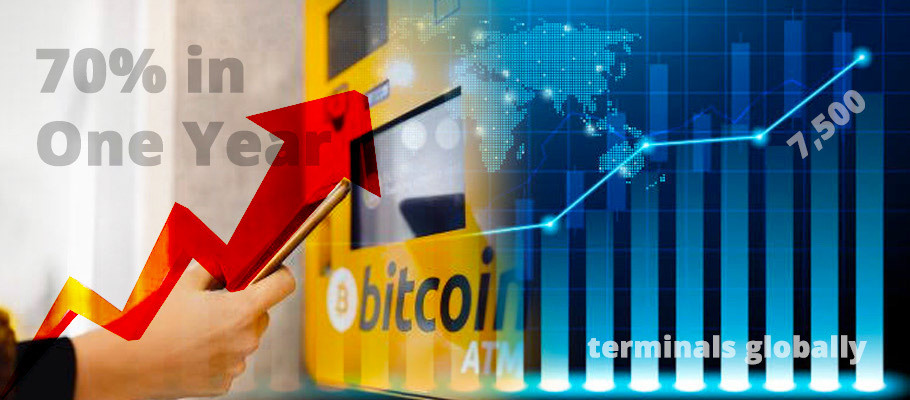
Published: April 23th, 2020
There are now more than 7,500 Bitcoin ATMs installed across the globe – a sure sign of digital currencies slow but steady move into the financial mainstream.
Numbers released by Coin ATM Radar this week show a 70 per cent increase in new active automated teller machines since April 2019. The first three months of 2020 alone saw just over 1,200 new Bitcoin ATMs installations.
It previously took four years for the industry to register 2,000 ‘live’ machines, between 2014 and 2018. At the beginning of 2017, only 985 Bitcoin ATMs were in operation globally.
The US dominates the industry with 5,422 installations and more than 70 per cent of global market share. Canada has 720 while the UK has 280 and Austria has 140.
Rising Bitcoin (BTC) prices before its sudden crash in March are credited with bringing interest back to the crypto ATM space, as more people look for accessible options for investing in digital assets.
Statistics from Google Trends show that searches for ‘cryptocurrency cash machines’ and related terms have more than doubled since last year.
Searches spiked in June 2019 when BTC’s price touched $13,000, then again in early January 2020 when the pre-COVID-19 bull market began.
Bitcoin ATM network operators now look to be in a pitched battle for market share. Bitcoin Depot briefly took the lead in early February when it topped 500 ATMs, but the following week competitor Coinsource said it had jumped ahead to top 600. Current numbers from Coin ATM Radar show CoinCloud in the lead with more than 650 machines live on its network.
The survival rate of ATM networks is closely related to size. While hundreds of network operators have popped up in recent years, firms that peaked at between 1 and 10 machines only lasted eighteen months on average, and since 2015 more than 300 have already closed down. Firms that hit the 100 or more machines mark have proven to be more resilient.
On the manufacturing side, there are more than 40 known crypto ATM suppliers, but the majority of production comes from a handful of majors. Genesis Coin claims the largest market share with 33.8 per cent of installed machines, followed by General Bytes at 30.7 per cent.
Bitcoin ATM transactions represented just a small fraction of BTC’s $4 billion 2019 payments volume, but even that number was dwarfed the $3.7 trillion of credit card payments made last year. Still, a growing number of traditional bricks & mortar businesses accept cryptocurrency for payment, notably large fast-food chains Subway and Burger King, while Amazon and Etsy accept crypto for online bill payments.
Crypto ATMs have occupied an obscure corner of consumer finance for years. The world’s first Bitcoin cash machine was installed at a coffee shop in downtown Vancouver, BC. in 2013. A year later, there were only four bitcoin ATMs in the US. It took roughly five years for the total number of worldwide Bitcoin ATM installations to hit 2,000.
So where is today’s surge in ATM demand coming from? With high fees taking a chunk out of the funds received or paid, analysts have suggested other reasons why ATMs are becoming more popular.
Anonymity may be one advantage. Users can obtain cryptocurrency by merely walking up to a machine rather than registering with an online service, though that advantage depends on the country and jurisdiction. In the US, for example, in Bitcoin ATMs are classified as Money Services Businesses, meaning they are subject to anti-money laundering (AML) and know-your-customer (KYC) laws.
The real early adopter market is more likely to be found in the millions of 'unbanked' consumers who don't have a regular savings or chequing account. For them, a bitcoin ATM is a way to take part in the digital economy, converting cash into digital holdings and using it to make e-commerce purchases, or pay bills online using their smartphones.
Crypto ATMs are also being utilised by some immigrants and expats who don’t have bank accounts but want to send money back to family and friends in their home countries. Wire services like Western Union and MoneyGram remain popular, but with legacy processes and systems leftover from the pre-internet days, they are seen as slow and cumbersome.
The coronavirus pandemic may also be pushing more consumers to consider cryptocurrencies as a safe haven asset, and some are increasing their holdings to protect savings against coming inflation.
In countries like such as Venezuela and Argentina, where hyper-inflation has severely impacted the value of fiat currencies, Bitcoin holdings have grown rapidly as regular citizens use it as a hedge against lost value.
Caracas switched on its first public Bitcoin ATM in January, and six more have already come online.
Alongside their growing popularity are concerns about security, and potential misuse of Bitcoin ATMs by fraudsters and organised crime.
Crypto cash machines are being targeted by scammers to trick people into giving up their cash. An Australian criminal scheme stole more than AUD 50,000 by convincing people they could pay-off their (false) tax owing’s at a discount if they did so using a Bitcoin ATM.
A con artist in Canada placed ‘out of order’ sign on several Bitcoin ATMs in the city of Winnipeg, directing users to send their bitcoin using a QR code printed on the sign as a temporary alternative.
Scams like this haven’t dampened enthusiasm for crypto ATMs yet. They continue to gain traction, but expanding regulatory action may put the brakes on network growth.
Spanish authorities have made Bitcoin ATMs a centrepiece of the ongoing campaign to stop criminals from circumventing anti-money laundering laws.